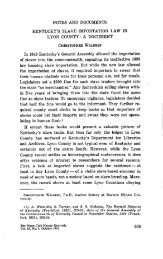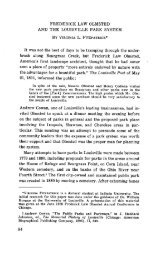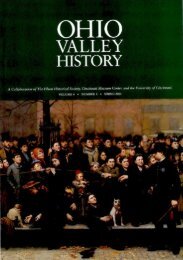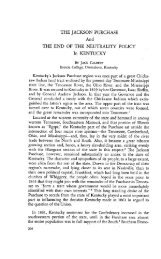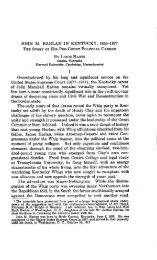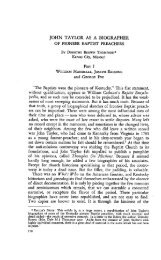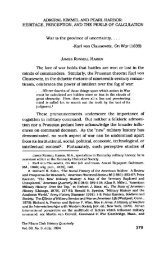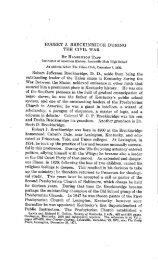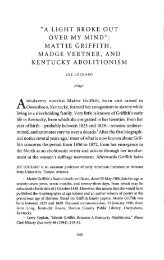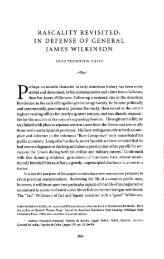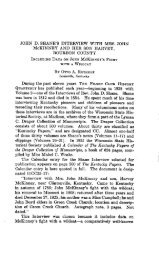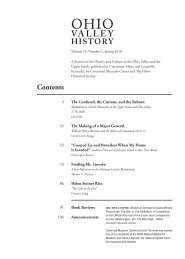the filson club history quarterly - The Filson Historical Society
the filson club history quarterly - The Filson Historical Society
the filson club history quarterly - The Filson Historical Society
You also want an ePaper? Increase the reach of your titles
YUMPU automatically turns print PDFs into web optimized ePapers that Google loves.
214 <strong>The</strong> <strong>Filson</strong> Club History Quarterly [Vol. 29<br />
This would make it near <strong>the</strong> present Berea in Madison County, Kentucky,<br />
u° Having lost <strong>the</strong>ir granite axes in fight or flight <strong>the</strong>y made<br />
new ones of sandstone which could not cut wood but could crack<br />
skulls. Fort Ancient in sou<strong>the</strong>rn Ohio dates from this time. <strong>The</strong>re<br />
are many o<strong>the</strong>r forted hilltops in <strong>the</strong> Akan land, makeshift and feeble,<br />
but each declaring defiance and defense; and each helpless against<br />
firearms.<br />
<strong>The</strong> Catawba tradition fur<strong>the</strong>r tells that <strong>the</strong>y left <strong>the</strong> Kentucky fort<br />
and fled along <strong>the</strong> Warriors' Path through Cumberland Gap into Virginia.<br />
<strong>The</strong> Virginia records21 tell how <strong>the</strong> horde irrupted into Virginia<br />
six hundred strong; how in 1656 <strong>the</strong>y whipped a Virginia army<br />
under Colonel Hill; and how Colonel Abram Wood was <strong>the</strong>n sent<br />
against <strong>the</strong>m who induced <strong>the</strong> desperate "Rickahockans" to move south<br />
towards <strong>the</strong> Carolinas.<br />
In this same year one band of <strong>the</strong>m asked admission into <strong>the</strong> Creek<br />
Confederacy and were settled on <strong>the</strong> Tallapoosa River, in Georgia,<br />
calling <strong>the</strong>ir town Tucket Batchet, "<strong>the</strong> town of <strong>the</strong> refugees.''m<br />
Here we must leave <strong>the</strong>m to <strong>the</strong>ir modern historians and watch <strong>the</strong><br />
spreading Iroquois fury.<br />
<strong>The</strong> Iroquois now assailed <strong>the</strong> Akaos next beyond, <strong>the</strong> Honiosants,<br />
Nyhyssans, Monohysanoughs, Onasiotos of <strong>the</strong> Scioto Valley; <strong>the</strong><br />
Mesopeleas (Monsouperias) of sou<strong>the</strong>astern Ohio, West Virginia, and<br />
nor<strong>the</strong>astern Kentucky; <strong>the</strong> Cheskapes and Misseouians of central Kentucky;<br />
<strong>the</strong> Akans of sou<strong>the</strong>rn Indiana and <strong>the</strong> Wabash Valley; and<br />
o<strong>the</strong>rs whose names are not given on <strong>the</strong> maps or elsewhere. Some<br />
fled through Cumberland Gap but most took to <strong>the</strong>ir canoes and fled<br />
down <strong>the</strong> Ohio.<br />
<strong>The</strong>re are but few data about <strong>the</strong>m. <strong>The</strong>re are two forts on<br />
Harrod's Creek in Oldham County, Kentucky, built evidently in a<br />
hurry, which can safely be attributed to <strong>the</strong> fleeing Akans? 3<br />
Some stopped at <strong>The</strong> Falls for awhile, as a Seneca chief tells La Salle<br />
<strong>the</strong>y were <strong>the</strong>re in 1669; and a pile of whitened human bones was<br />
found by <strong>the</strong> Virginia settlers on Sandy Island just below <strong>The</strong> Falls.<br />
Tobacco, a Miami chief, told General George Rogers Clark <strong>the</strong>y were<br />
relics of a battle after which <strong>the</strong> ancient inhabitants fled down <strong>the</strong><br />
river and Kentucky was lost.<br />
Col. James F. Moore, of Kentucky, was told by an old Indian that<br />
<strong>the</strong> early Kentuckians had perished in a war waged against <strong>the</strong>m by<br />
Indians, and that in <strong>the</strong> last great battle <strong>the</strong> defenders were driven<br />
to a small island below <strong>the</strong> Ohio Falls where <strong>the</strong>y were cut to pieces.<br />
Cornstalk told Colonel McKee, commander on <strong>the</strong> Kanawha, that<br />
Ohio and Kentucky had once contained a white people, familiar with<br />
arts of which <strong>the</strong> Indians [Algonquians and Iroquois] knew nothing,



